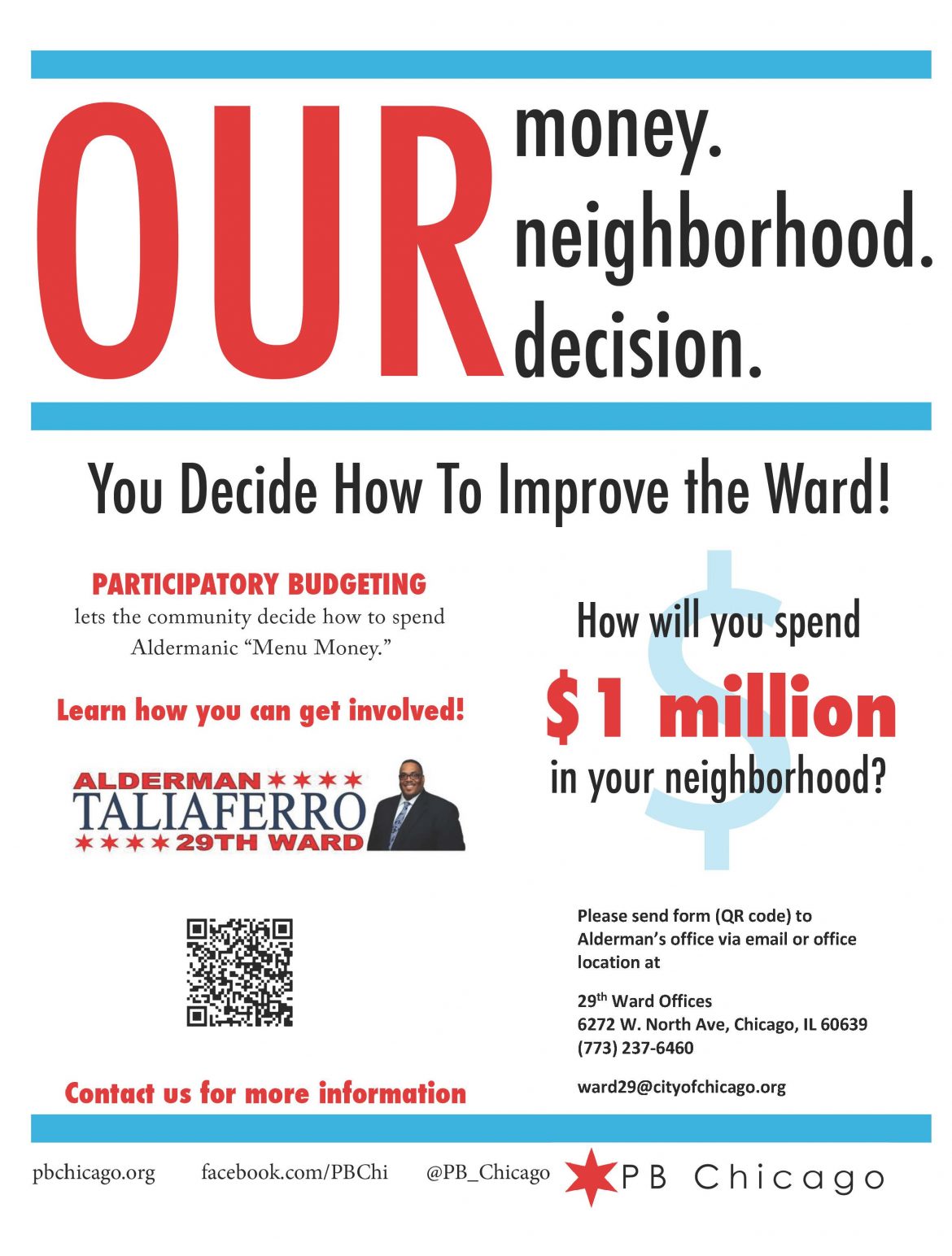From our partners at the Austin Weekly News:
This year, 29th Ward residents will once again get a chance to have their say in how $1 million in “aldermanic menu” money will be spent, though the process will look somewhat different due to COVID-19.
Every year, each of the city’s 50 aldermen get $1.4 million in “menu money” to spend on infrastructure-related projects, ranging from fixing up sidewalks to painting murals.
Ald. Chris Taliaferro (29th) is the only West Side alderman to allow residents to suggest ideas and vote on how that money will be spent through the process known as participatory budgeting.
This year, much of what would normally happen in person is happening virtually. Taliaferro is collecting ideas and recruiting volunteers online.
It is not currently clear how the voting will look like or when it will take place, but it is expected to be some combination of in-person and online voting.
When Taliaferro originally ran for office in 2015, he promised to bring participatory budgeting to 29th Ward if elected. He didn’t do it during his first year in office, saying that there was a backlog of street resurfacing needs that had to be taken care of as soon as possible.
But he introduced participatory budgeting for a portion of the menu funding the following year, and, with some modifications, the process has happened every year since.
In the past, the 29th Ward hosted idea collection workshops, and residents and community organizations were welcome to submit their ideas to the ward office. The committee of volunteer community representatives then met to decide which projects should go on the ballot.
The ward staff then looked at whether there was enough menu money to cover the costs of those projects, and whether there were any legal or jurisdictional issues that would need to be addressed.
Once the ballot was finalized, residents had to vote on two items: how much of the money would go toward street resurfacing and which non-street resurfacing projects the money should be spent on.
Residents could vote for up to three projects. Any 29th Ward resident who is at least 14 years old can vote.
The projects that are selected are based on both the number of votes and how much money the majority of residents chose to spend on non-street resurfacing needs, so the more money that goes toward street resurfacing, the less money is available for everything else.
Byron Watson, Taliaferro’s staff assistant, explained that because of the pandemic, the idea collection is happening virtually.
Residents have until Sept. 19 to submit ideas using online forms here. A Spanish-language version available here.
The forms also let residents sign up to volunteer. The ward office held a virtual community meeting Aug. 19 to discuss idea collection.
Even before the pandemic, participation has been an ongoing issue. While the number of voters has increased over the years, it’s still a small portion of the ward population.
Watson said they intend to rely on participatory budgeting team leaders – volunteer community stakeholders – to help get the word out about the process and encourage residents to be involved. They also plan to promote participatory budgeting at ward events and tell anyone who visits the ward office about it.
No decision has been made on when the vote will take place.
“After finalizing which projects make the ballot, then we have to engage our neighbors to vote,” Watson said. “We did online voting last year so, I would imagine we will do both in-person and online voting.”
Progress on last year’s projects
Last year, 330 residents voted to spend $600,000 out of $1 million on street resurfacing. The winning projects included light pole community markers along Central Avenue and Austin Boulevard; Columbus Park tennis court flood lights; adding a pedestrian island and pedestrian crossing bump-outs on the portion of North Avenue, mid-way between Natchez and Nagle avenues; and improvements to Rutherford Sayre Park, Harambee and Austin Green Team community gardens.
Watson said those projects are still works in progress. The ward has been working with the Chicago Department of Cultural Affairs and Special Events on the specifics of where the light pole signs will go; Watson said he expects them to be installed in the first quarter of 2021.
But the timeline for the Columbus Park flood lights is less certain, because negotiations with the Chicago Park District are still ongoing, and North Avenue improvements won’t go ahead at all because Illinois Department of Transportation, which has jurisdiction over it because it’s a state highway, “said no” to the project.
PB Chicago is coordinated out of UIC’s Great Cities Institute as part of the Neighborhood Initiative.
For more info, contact Ald. Taliaferro’s office, 6272 W. North Ave., or call (773) 237-6460.
